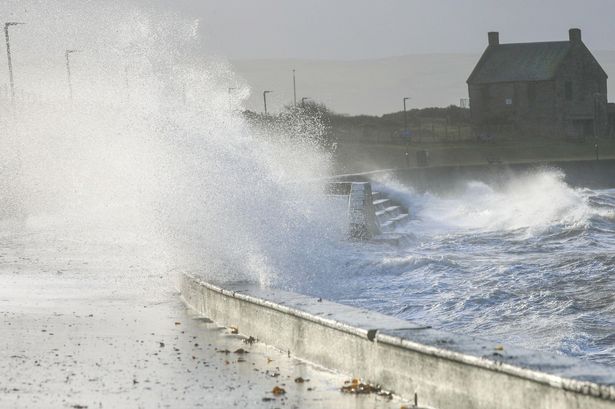Storm Eowyn, an impending weather system poised to impact the United Kingdom, has prompted a stark warning from a meteorological expert at the University of Reading. The expert has characterized the storm as potentially the “most formidable” to strike the country in several decades, raising concerns about its potential for widespread disruption and damage. While specific details regarding the storm’s projected trajectory and intensity are still being analyzed, the initial assessment paints a picture of a powerful weather event capable of producing a confluence of hazardous conditions, including violent winds, torrential rainfall, coastal flooding, and potentially even heavy snowfall in certain regions. The seriousness of the warning underscores the need for proactive preparedness measures by individuals, communities, and relevant authorities to mitigate the potential impact of this formidable storm.
The heightened concern surrounding Storm Eowyn stems from a convergence of meteorological factors that are predicted to amplify its intensity and impact. Firstly, the storm is expected to draw upon an unusually large reservoir of warm, moist air from the Atlantic Ocean, providing it with an abundant source of energy to fuel its development. This influx of warm, moist air is likely to contribute to the formation of intense low-pressure systems, which in turn drive strong winds and heavy precipitation. Secondly, the storm’s projected track is anticipated to bring it into contact with colder air masses over land, creating a sharp temperature gradient that can further intensify the storm’s dynamics. The interaction between these contrasting air masses can lead to the development of rapidly intensifying winds and potentially even thunderstorms embedded within the larger storm system. Finally, the timing of the storm coincides with a period of high tides in certain coastal areas, increasing the risk of significant coastal flooding and erosion due to storm surge. This combination of factors makes Storm Eowyn a particularly potent threat, demanding careful monitoring and preparation.
The potential impacts of Storm Eowyn are multifaceted and pose a range of challenges. High winds, potentially reaching hurricane force in some areas, pose a significant threat to infrastructure, including power lines, trees, and buildings. Widespread power outages are a distinct possibility, potentially disrupting essential services and communication networks. Heavy rainfall can lead to widespread flooding in both urban and rural areas, posing risks to homes, businesses, and transportation infrastructure. The combination of strong winds and heavy rain can also increase the risk of landslides, particularly in hilly or mountainous terrain. Coastal areas are particularly vulnerable to the combined effects of high winds, storm surge, and heavy rainfall, with the potential for significant erosion, flooding, and damage to coastal properties. The storm’s potential for heavy snowfall in some regions could further exacerbate the challenges, adding to the disruption and hindering transportation and emergency response efforts.
In light of the anticipated severity of Storm Eowyn, proactive preparedness measures are crucial to mitigating its potential impacts. Individuals are advised to secure loose objects around their homes, ensure they have adequate supplies of food, water, and medications, and stay informed about the storm’s progress through official channels. Coastal residents should be prepared for potential evacuation orders and have a plan in place for relocating to safer areas. Businesses should review their emergency preparedness plans and take steps to protect their assets and employees. Local authorities and emergency services should be prepared to respond to power outages, flooding, and other emergencies. Effective communication and coordination between different agencies are essential for a coordinated and efficient response to the storm’s impacts.
The precise forecasting of storm intensity and trajectory remains inherently challenging, and there is always a degree of uncertainty associated with weather predictions. However, the consensus among meteorological experts regarding the potential severity of Storm Eowyn underscores the importance of taking the warnings seriously and preparing accordingly. While the exact scale and location of the storm’s impacts remain to be seen, the potential for widespread disruption and damage is undeniable. Proactive preparedness measures, both individual and collective, are critical for minimizing the negative consequences of this powerful weather event and ensuring the safety and well-being of communities in the storm’s path. Continuous monitoring of the storm’s development and adherence to official guidance are essential for navigating the challenges posed by Storm Eowyn and minimizing its impact.
The unfolding situation with Storm Eowyn serves as a stark reminder of the power of nature and the importance of being prepared for severe weather events. While advances in meteorology have improved our ability to predict and track storms, they remain complex and dynamic phenomena, and their precise impacts can be difficult to predict with absolute certainty. The potential for Storm Eowyn to be the “most formidable” in decades underscores the need for ongoing investment in weather forecasting capabilities, emergency preparedness infrastructure, and public awareness campaigns to ensure communities are well-equipped to cope with the increasing frequency and intensity of extreme weather events. The lessons learned from Storm Eowyn will undoubtedly inform future preparedness strategies and contribute to building more resilient communities in the face of the ongoing challenges posed by a changing climate.














